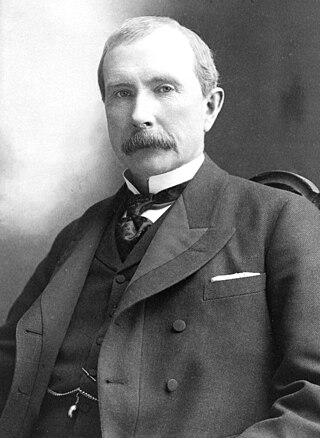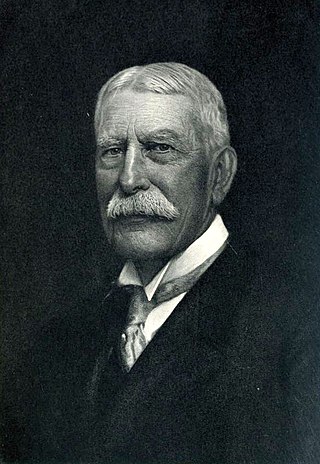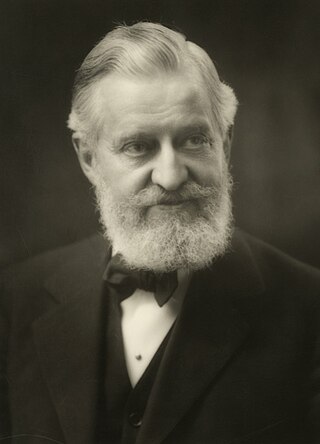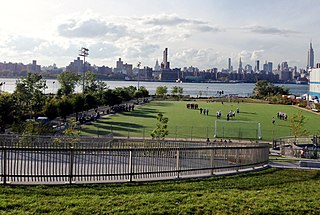
The history of the petroleum industry in the United States goes back to the early 19th century, although the indigenous peoples, like many ancient societies, have used petroleum seeps since prehistoric times; where found, these seeps signaled the growth of the industry from the earliest discoveries to the more recent.
Kerosene is a combustible hydrocarbon liquid which is derived from petroleum. It is widely used as a fuel in aviation as well as households. Its name derives from Greek: κηρός (keros) meaning "wax", and was registered as a trademark by Canadian geologist and inventor Abraham Gesner in 1854 before evolving into a generic trademark. It is sometimes spelled kerosine in scientific and industrial usage.
Standard Oil Company, Inc., was an American oil production, transportation, refining, and marketing company that operated from 1870 to 1911. At its height, Standard Oil was the largest petroleum company in the world, and its success made its co-founder and chairman, John D. Rockefeller, among the wealthiest Americans of all time and among the richest people in modern history. Its history as one of the world's first and largest multinational corporations ended in 1911, when the U.S. Supreme Court ruled that it was an illegal monopoly.

Venango County is a county in the Commonwealth of Pennsylvania. As of the 2020 census, the population was 50,454. Its county seat is Franklin. The county was created in 1800 and later organized in 1805.

John Davison Rockefeller Sr. was an American business magnate and philanthropist. He has been widely considered the wealthiest American of all time and the richest person in modern history. Rockefeller was born into a large family in Upstate New York who moved several times before eventually settling in Cleveland. He became an assistant bookkeeper at age 16 and went into several business partnerships beginning at age 20, concentrating his business on oil refining. Rockefeller founded the Standard Oil Company in 1870. He ran it until 1897 and remained its largest shareholder.

Henry Morrison Flagler was an American industrialist and a founder of Standard Oil, which was first based in Ohio. He was also a key figure in the development of the Atlantic coast of Florida and founder of the Florida East Coast Railway. He is also known as a founder of the cities of Miami and Palm Beach, Florida.

Greenpoint is the northernmost neighborhood in the New York City borough of Brooklyn, in the U.S. state of New York. It is bordered on the southwest by Williamsburg at Bushwick Inlet Park and McCarren Park; on the southeast by the Brooklyn–Queens Expressway and East Williamsburg; on the north by Newtown Creek and the neighborhood of Long Island City in Queens; and on the west by the East River. The neighborhood has a large Polish immigrant and Polish-American community, containing many Polish restaurants, markets, and businesses, and it is often referred to as Little Poland.

Henry Huttleston Rogers was an American industrialist and financier. He made his fortune in the oil refining business, becoming a leader at Standard Oil. He also played a major role in numerous corporations and business enterprises in the gas industry, copper, and railroads. He became a close friend of Mark Twain.

Henry Clay Folger Jr. was president and later chairman of Standard Oil of New York, a collector of Shakespeareana, and founder of the Folger Shakespeare Library.

Charles Pratt was an American businessman. Pratt was a pioneer of the U.S. petroleum industry, and he established his kerosene refinery Astral Oil Works in Brooklyn, New York. He then lived with his growing family in Clinton Hill, Brooklyn. He recruited Henry H. Rogers into his business, forming Charles Pratt and Company in 1867. Seven years later, Pratt and Rogers agreed to join John D. Rockefeller's Standard Oil.

Williamsburg is a neighborhood in the New York City borough of Brooklyn, bordered by Greenpoint to the north; Bedford–Stuyvesant to the south; Bushwick and East Williamsburg to the east; and the East River to the west. It was an independent city until 1855, when it was annexed by Brooklyn; at that time, the spelling was changed from Williamsburgh to Williamsburg.

Newtown Creek, a 3.5-mile (6-kilometer) long tributary of the East River, is an estuary that forms part of the border between the boroughs of Brooklyn and Queens, in New York City. Channelization made it one of the most heavily-used bodies of water in the Port of New York and New Jersey and thus one of the most polluted industrial sites in the United States, containing years of discarded toxins, an estimated 30,000,000 US gallons of spilled oil, including the Greenpoint oil spill, raw sewage from New York City’s sewer system, and other accumulation from a total of 1,491 sites.
The South Improvement Company was a short lived Pennsylvania corporation founded in late 1871 which existed until the state of Pennsylvania suspended its charter on April 2, 1872. It was created by major railroad and oil interests, and was widely seen as part of John D. Rockefeller's early efforts to organize and control the oil industry in the United States under Standard Oil. The company's purpose was to end a rate war with the rail trunk lines by dividing oil traffic more evenly between the Pennsylvania Railroad, the Erie Railroad, and the New York Central railroads. The second purpose of the company was to limit production of refined oil - the country had a daily refining capacity of 40,000 barrels and a market for only 16,000. Although the company never shipped any oil, the South Improvement Company scheme caused widespread attention to be focused on the relationships between big railroads and big businesses which wanted and demanded favorable treatment. In what would become known as the Cleveland Massacre, John D. Rockefeller and Henry Flagler bought eighteen refineries, only one of which wasn't located in Cleveland over a month's time between mid-February and mid-March 1872.

Charles Pratt and Company was an oil company that was formed in 1867 by Charles Pratt and Henry H. Rogers in Brooklyn, New York. It became part of John D. Rockefeller's Standard Oil organization in 1874.
Wamsutta Oil Refinery was established around 1861 in McClintocksville in Venango County near Oil City, Pennsylvania, in the United States. It was the first business enterprise of Henry Huttleston Rogers (1840–1909), who became a famous businessman, industrialist and financier.
McClintockville, Pennsylvania was a small community in Cornplanter Township in Venango County located in the state of Pennsylvania in the United States.
The Greenpoint oil spill is one of the largest oil spills ever recorded in the United States. Located around Newtown Creek in the Greenpoint neighborhood of Brooklyn, New York City, between 17 and 30 million US gallons of oil and petroleum products have leaked into the soil from crude oil processing facilities over a period of several decades. The spill was first noticed in 1978, and soil vapor tests were still reported as returning positive in 2008.

The Astral Apartments is an apartment building located at 184 Franklin Street in Greenpoint, Brooklyn, New York City. The Astral was built in 1885–1886 as affordable housing for employees of Charles Pratt's Astral Oil Works. It is a block-long brick and terra cotta building in the Queen Anne style. It features a central projecting section with a deep, three-story-high round arch recess. The roof features inward-looking decorative grotesques. Original amenities of the building included a settlement house, library, and kindergarten.

Bushwick Inlet Park is a public park in the Williamsburg neighborhood of Brooklyn, New York City. The park currently consists of two non-contiguous sections along the East River and is eventually planned to reach into Greenpoint at Quay Street. The park is named for the nearby Bushwick Inlet, which it is planned to encompass upon completion.














